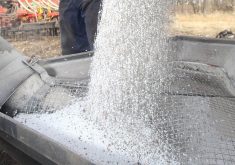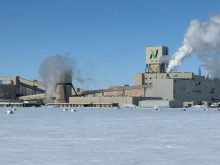Doug Chorney pre-booked his spring fertilizer but didn’t lock in a price because he thought it was too high at the time.
Last week he got a call from his anhydrous ammonia supplier.
“They thought this was the time to price it,” said the farmer from East Selkirk, Man.
Chorney locked in a price of $1,050 per tonne delivered to the farm, which is down from $1,100 before Christmas.
“Although I’m not thrilled with that price, it is a little better,” he said.
Read Also

Farming Smarter receives financial boost from Alberta government for potato research
Farming Smarter near Lethbridge got a boost to its research equipment, thanks to the Alberta government’s increase in funding for research associations.
David Asbridge, president of NPK Fertilizer Advisory Service, thinks Chorney made a prudent decision.
“We think we’re probably pretty close to the bottom of these markets,” said the U.S. analyst.
The average wholesale price for urea in the U.S. Midwest for the first half of February was $440 per short ton, which is up slightly from a year ago but down sharply from the average of $537 in September 2011.
Asbridge believes the freefall is nearly over and prices will start heading back up in the next two to four weeks as spring approaches.
“(Farmers) probably should go ahead and start thinking about buying some of their fertilizer.”
“We’re at a point now where I don’t think there’s a whole lot of downside to current prices,” he said.
Fertilizer prices shot up in the summer of 2011 when markets realized that the corn crop was going to be short. That led to record high corn futures, which dragged fertilizer along for the ride in addition to expectations for a much bigger U.S. corn crop in 2012 and the corresponding need for fall fertilizer application.
Markets started to soften in December when the U.S. Department of Agriculture released a report showing corn stocks weren’t as tight as originally anticipated.
Falling prices have made fertilizer retailers reluctant to stock their shelves. They recall getting stuck with high-priced inventory in 2007 and 2008 that they had to sell at a loss.
“The retailers are really not willing to step up and load up with a bunch of inventory that they’re not sure they’re going to be able to sell at a profit,” Asbridge said.
However, they will have to start buying soon because fertilizer demand is expected to be strong this spring. U.S. growers intend to plant more wheat and corn, which are fertilizer intensive crops. As well, acres that were lost to flooding in 2011 in the United States and Canada will likely come back into production this year.
Garth MacDonald, chief executive officer of G-Mac’s AgTeam Inc., an independent crop input retailer, said the lack of a public pricing system in Western Canada makes it hard to get a good picture of trends in this country.
The Canadian market is different from the U.S. market. It tends to follow the same peaks and valleys, but the ups and downs are far less dramatic.
“There is less volatility and sometimes that’s good and sometimes it’s bad,” he said.
Fertilizer prices have dropped in Western Canada since summer, but they haven’t plummeted like they have south of the border.
MacDonald said he is no analyst, but he agrees with Asbridge that prices could creep higher in the spring.
“If growing conditions are average to better, demand will be stronger than usual because the price of canola is above a five-year average, and so are the other crops that farmers are growing,” he said. “It’s a good time to invest in growing a crop.”
Richard Downey, vice-president of investor and corporate relations with Agrium, is also forecasting strong sales this spring.
“Overall, we envision very good demand for really all three nutrients, but particularly for nitrogen,” he said.
“Nitrogen is one of those nutrients you can’t skip out on. There is an immediate yield impact and with cash margins the way they are, nitrogen demand clearly will be good.”
Agrium is forecasting 94 million acres of U.S. corn in 2012, up 2.1 million acres from last year. Corn is a big user of nitrogen fertilizer.
Asbridge expects fertilizer prices to return to the traditional pattern of spikes in the spring and fall and slumps in the summer and winter, so growers would be well advised to hold off on booking their fall fertilizer needs until summer.
A large phosphate facility is coming on stream in Saudi Arabia and there has been lots of nitrogen capacity expansion in China and the Middle East.
“That’s what is going to put pressure on prices this summer,” he said.
Chorney said high nitrogen prices have changed the way he farms. One-third of his 1,500 acre farm is now seeded to soybeans, which don’t require nitrogen.
He locked in soybeans for $11.30 per bu., which is slightly lower than the $12 price he received for his 2012 canola. Both crops yield around 40 bushels per acre on his farm.
The difference is that he needs to apply 100 pounds of nitrogen, 20 lb. of sulfur and 25 lb. of phosphate per acre of canola.
“That’s an expensive cocktail to grow a canola crop,” said Chorney.

















